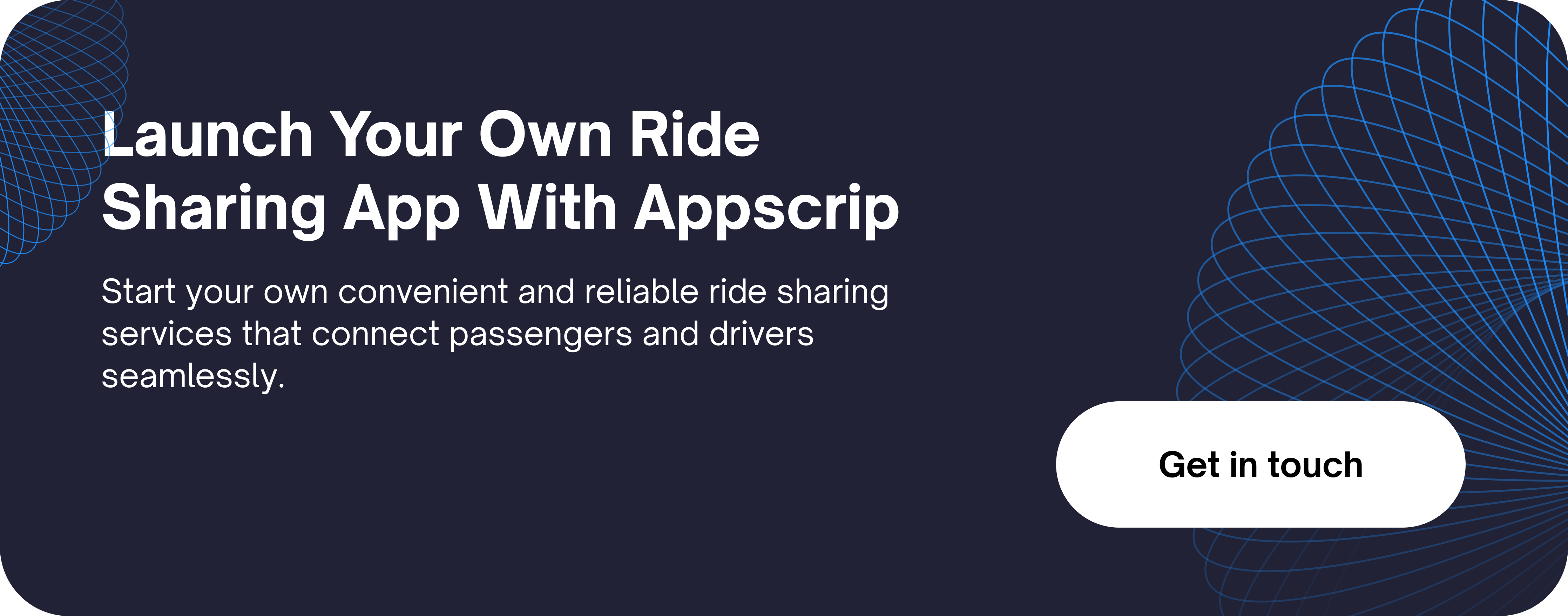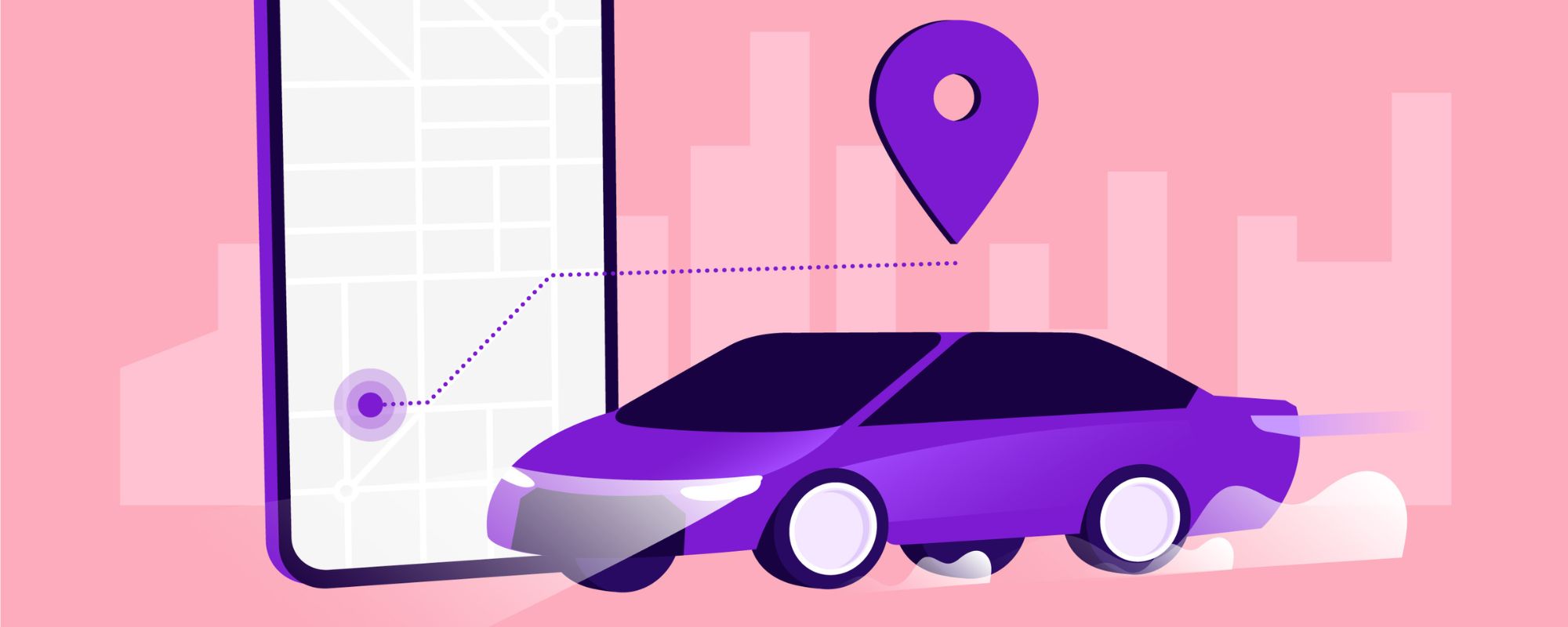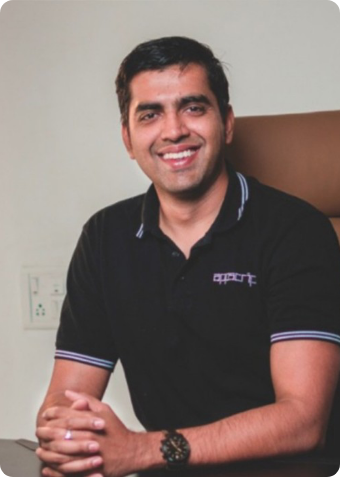The ride-sharing industry is experiencing increased acceptance as it is revolutionising the way people travel and commute. The advent of smartphone technology and demand for convenient transportation, birthed ride-sharing apps that gained immense popularity and disrupted traditional modes of travel.
We detail here the cost to build a ride-sharing app. Building a ride-sharing app involves a comprehensive understanding of various factors as stated below.
Estimated Time, Cost & Features For App Development
| Type of App | Timeline | Cost | Features |
| Simple App | 3 – 6 Months | $30,000-$50,000 | • User registration and login • Ride request and booking • Driver registration and verification • Basic map integration for tracking rides • Fare estimation • Payment integration • Ride history and rating system |
| Complex App | 6 – 10 Months | $50,000-$90,000 | • Advanced map and real-time location tracking • In-app messaging and notifications • Multi-language support • Split fare option for multiple passengers • Driver earnings and incentive management • User & driver profiles with customisation options • SOS and safety features • Ride-sharing pool options • Promo code and referral system |
| Highly Complex App | 10 – 15 Months | $90,000-$120,000 | • AI-powered route optimisation and demand prediction • Advanced analytics and data visualisation • Integration with third-party services (e.g., public transport, food delivery) • Voice-based commands and integration with virtual assistants • Augmented Reality (AR) navigation • Enhanced security features (biometric authentication, facial recognition) • Custom loyalty programs and rewards system • Multimodal transportation options (bike-sharing, scooters, etc.) • Dynamic pricing and surge management algorithms |
Understanding the Components of a Ride-sharing App
The basic components of a ride-sharing app can be broadly categorised into three main sections: customer app, driver app, and admin panel.
Customer App Features
| Functionality | Details |
| User Registration and Authentication | Users can register using their phone number, email, or social media logins and complete the authentication process. |
| Book A Ride | Customers can book a ride by choosing their pickup and drop locations. |
| User Profile Management | Users can manage their profiles, update personal info, upload a picture, mention ride preferences, and view ride history. |
| Customer Preferences | Customers can choose the kind of vehicle they prefer and driver too. |
| Call Masking Feature | Customers can call the driver without revealing their contact details. |
| Multiple Pickup Points | Multiple pickup points can be enabled if necessary. |
| Chat Option | Customer and driver can chat with each other. |
| Payment Integration | Various payment options are available such as credit/debit cards, digital wallets, and cash. |
| Fare Breakdown | Detailed invoice with fare breakdown is provided after every trip. |
| Rating, Reviews & Tips | Users can rate, review and tip the driver as per the experience. |
Driver App Features
| Functionality | Details |
| Driver Registration and Verification | Drivers need to register, create accounts, and verify their identity, documents, and background. |
| Driver Profile Management | Drivers can manage their profiles, upload picture, personal info, and necessary documents. |
| Accept/Reject a Ride | Drivers may choose to accept or reject a ride request. |
| Ride Cancellation | Drivers can cancel a ride specifying a reason. |
| Waiting Charges | Waiting charges applicable after a specified duration |
| Live Tracking | Drivers can be live tracked to the pick-up and drop locations in real-time. |
| Ride History | Drivers can check the details of all the rides completed till date. |
| Invoice Details | Drivers get a detailed invoice showing their earnings at the end of a trip. |
| Add/Withdraw Money | Drivers can add or withdraw money from the wallet to their bank. |
| Ratings and Feedback | Drivers can rate customers and provide feedback based on their experience. |
Admin Panel Components
| Functionality | Details |
| User and Driver Management | Administrators can manage user and driver accounts, complete the verification processes, and perform driver onboarding. |
| Ride Monitoring | Admin can monitor rides in real-time and track their statuses. |
| Manual Bookings | Dispatchers can manually book a ride on behalf of a customer/driver. |
| Surge Pricing/Peak Time Pricing | Surge pricing can be enabled for certain areas and during specific time by the admin. |
| Assign Rides | Dispatcher can assign rides to drivers available near the booking area. |
| Bird’s Eye View | Overall view of all the scheduled and on-going rides and its details are available for any specific location. |
| Ride Tracking | Rides can be tracked in real-time along with customer and driver details. |
| Analytics | Analytics and reporting features provide valuable insights into user behaviour and ride statistics. |
| Support and Dispute Resolution | Admin to address user queries, resolve disputes, and handle complaints. |
| Promotions and Incentives | Admins can create and manage promotional campaigns, discounts, and incentives to attract and retain users and drivers. |
| Platform Customisation | Customisation allows admin to personalise the app’s branding, design, and content. |
Tech Stack
A ride-sharing app requires a well-rounded and efficient tech stack to handle various functionalities and ensure a smooth user experience. Here’s an ideal tech stack:
| Functionality | Technology |
| User Interface (UI) and User Experience (UX) | React Native, Flutter, or native development for iOS (Swift) and Android (Kotlin/Java) to build cross-platform or native apps. |
| Backend Development | Node.js, Python (Django or Flask), Ruby (Ruby on Rails), or Go for scalable and efficient backend development. |
| Real-Time Data Processing | WebSocket for real-time communication between the app and server. |
| Mapping and Geolocation | Google Maps API, Mapbox, or other mapping services for location-based functionalities. |
| Location Tracking | GPS and Geolocation APIs to track the user’s and driver’s location. |
| Routing and Navigation | Algorithms like Dijkstra’s or A* for efficient route planning & navigation. |
| Payment Integration | Stripe, Braintree, or other payment gateways to handle secure and convenient payments. |
| Push Notifications | Firebase Cloud Messaging (FCM) or Apple Push Notification Service (APNs) for real-time updates and notifications. |
| Database Management | PostgreSQL, MySQL, MongoDB, or other databases for storing user data, ride history, etc. |
| Authentication and Security | OAuth, JWT (JSON Web Tokens), or Firebase Authentication for secure user authentication. |
| Cloud Services | Amazon Web Services (AWS), Microsoft Azure, or Google Cloud Platform (GCP) for scalable infrastructure and storage. |
| Analytics and Crash Reporting | Google Analytics, Firebase Analytics, or Mixpanel for tracking user behaviour, and services like Crashlytics for monitoring app crashes. |
| SMS and Email Integration | Twilio or other SMS gateways for verifying phone numbers and sending notifications. |
| Driver Management System | Admin panel built with React, Angular, or Vue.js to manage drivers, rides, and support operations. |
| Review and Rating System | Implement a custom rating system with database support. |
| Search and Filters | Elasticsearch or a similar search engine for efficient search and filtering of drivers and rides. |
| App Performance Monitoring | Tools like New Relic or Sentry to monitor app performance and detect issues. |
Factors Influencing the Cost of Building a Ride-Sharing App
Platform Selection
The choice of platform to develop a ride-sharing app has a significant role in determining its cost. There are three primary options:
- Native App Development (iOS and Android)
- Hybrid App Development
- Web App Development
Feature Set and Complexity
The features included in the ride-sharing app and their complexity impacts the development cost.
| Complexity Of The App | Details |
| Basic Features | Basic features include user registration, ride booking, real-time tracking, fare estimation, and payment integration. |
| Advanced Features | Advanced features like driver rating, surge pricing, split fare, in-app chat, and driver/passenger profiles enhances user experience. |
| Additional Integrations | Integrating with third-party services such as maps, GPS navigation, payment gateways, and social media platforms. |
| Customisations and Localisation | Customising the app’s design, language support, and regional / localisation requirements will add to the cost. |
Design and User Experience
Design and user experience of a ride-sharing app greatly influences its success and user adoption.
The factors:
- UI/UX Design
Investing in a well-designed and intuitive UI and UX is crucial. This includes designing user-friendly interfaces, easy navigation, and seamless interactions to enhance usability.
- Branding and Logo
Creating a unique brand identity and logo that aligns with the app’s purpose and target audience can contribute to its recognition and trust.
- App Icon
A visually appealing and memorable app icon can help differentiate the ride-sharing app from competitors and improve its visibility.
- Responsive Design
Responsive design ensures an app’s compatibility with various screen sizes and devices to improve user accessibility and satisfaction.
Development Team
The choice of development team also impacts the cost to build a ride-sharing app and quality of the app:
- In-House Development
- Outsourcing Development
- Freelancers vs. Agencies
Estimating the Cost to Build a Ride-Sharing App
Estimating the cost to build a ride-sharing app involves several phases and considerations. A brief overview of each phase and associated costs:
Research and Planning Phase
During this phase, the groundwork is laid for the app development process. The costs involved may include:
Defining Requirements and Scope:
This involves gathering and documenting features and functionalities required for the app. The cost will depend on the complexity of the app and the time for thorough analysis.
Market Analysis and Competitor Research:
Conducting market research helps identify user preferences, market trends, and competition. The cost will depend on the extent of research required and any external resources utilised.
Building Wireframes and Prototypes:
Wireframes and prototypes visually represent the app’s structure and user interface. The cost to build a ride-sharing app will depend on the complexity and number of screens to be designed.
Development Phase:
The development phase involves transforming the app concept into a functional product. The costs may include:
Front-End Development:
This involves creating the user interface and implementing the app’s design. The cost depends on the complexity of the design and the number of screens.
Back-End Development:
Backend development involves building the server-side infrastructure, database management, and integrating necessary functionalities. Cost will depend on complexity and scalability requirements.
API Development and Integration:
If integrating with third-party services (e.g., payment gateways, mapping APIs), additional costs may be incurred based on the complexity of integration and licensing fees.
Testing and Quality Assurance:
It is crucial to thoroughly test the app to ensure its functionality, usability, and security. The cost will depend on the scope of testing and the time required for bug fixing and improvements.
Post-Launch Costs:
After launching the app, ongoing maintenance and support are necessary to ensure its smooth operation and user satisfaction. The costs may include:
- App Store Submission and Maintenance
- Ongoing Support and Updates
- Marketing and User Acquisition
Conclusion: Cost to build a ride-sharing app
It’s important to note that the actual cost to build a ride-sharing app can vary significantly depending on factors like the app’s complexity, development team rates, geographical location, and any additional features or customisations required. Engaging with a professional app development agency or consulting with experts can help provide a more accurate estimate based on specific project requirements.

After an Engineering degree and a Diploma in Management I devoted 16+ years working in the automotive industry. My innate skill and extreme passion in writing, encouraged me to adopt it up as a profession. I have been writing for more than 10+ years in the software industry. The 400+ blogs I published are informative, exhaustive and interesting to a professional and causal reader.








